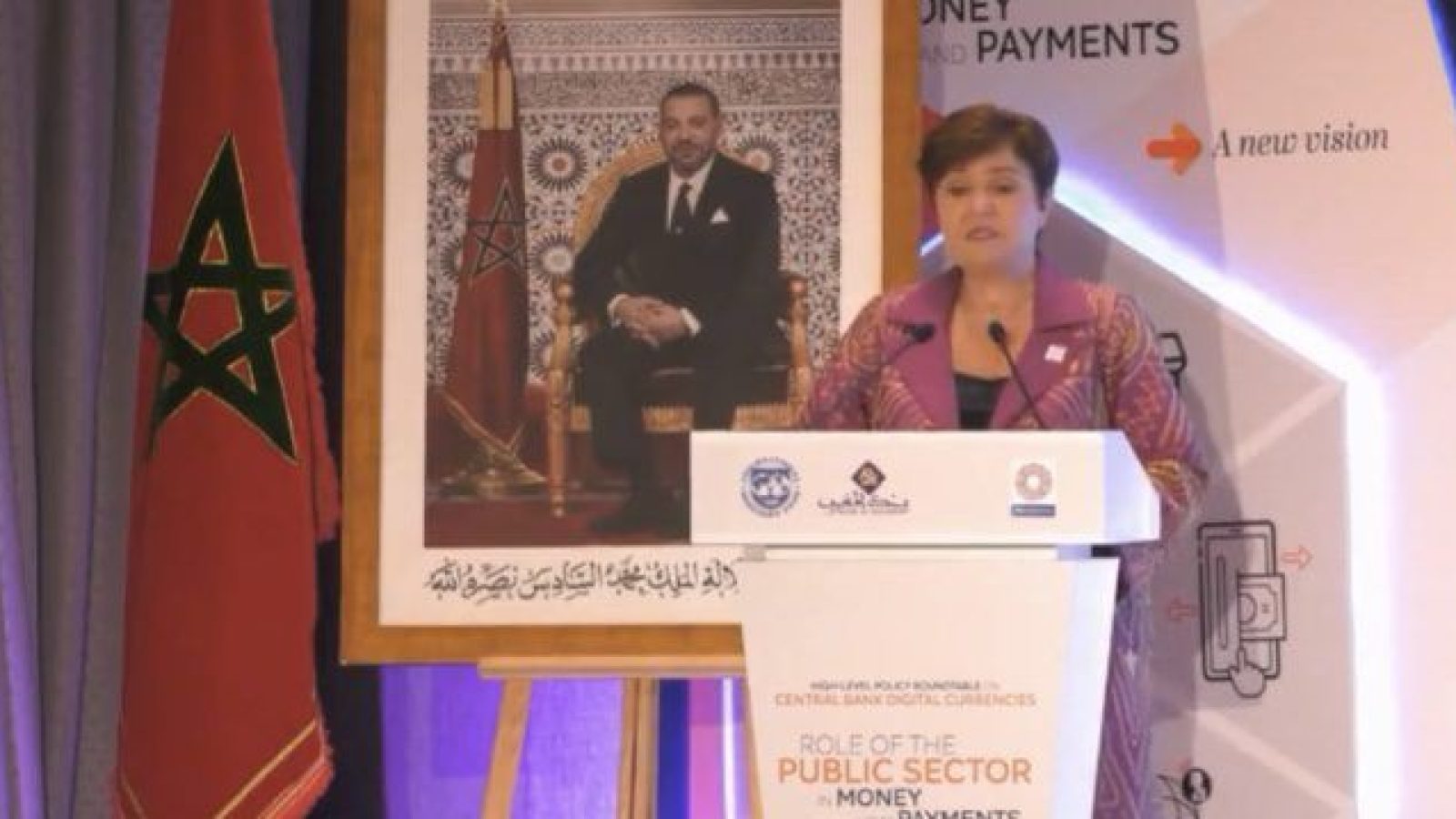“The International Monetary Fund (IMF) is working on a platform for central bank digital currencies (CDBCs) to enable transactions between countries,” per Reuters.
NEW – International Monetary Fund (IMF) is working on "a platform" for central bank digital currencies (CDBCs) to enable transactions between countries.https://t.co/rOIcuqgxOT
— Disclose.tv (@disclosetv) June 20, 2023
“If we are to be successful, CBDCs should not be fragmented national propositions. To have transactions more efficient and fairer, we need systems that connect countries,” IMF Managing Director Kristalina Georgieva said at a conference in Morocco attended by African central banks.
“At the IMF we are working hard on the concept of a global CBDC platform,” she added.
WATCH:
"At the IMF we are working hard on the concept of a global CBDC platform": IMF Managing Director Kristalina Georgieva https://t.co/Py7JLMovuc pic.twitter.com/N6txNHBaaE
— Tim Hinchliffe (@TimHinchliffe) June 19, 2023
Reuters reports:
The IMF wants central banks to agree on a common regulatory framework for digital currencies that will allow global interoperability. Failure to agree on a common platform would create a vacuum that would likely be filled by cryptocurrencies, she said.
ADVERTISEMENTA CBDC is a digital currency controlled by the central bank, while cryptocurrencies are nearly always decentralised.
Already 114 central banks are at some stage of CBDC exploration, “with about 10 already crossing the finish line”, she said.
“If countries develop CDBCs only for domestic deployment we are underutilizing their capacity,” she added.
CBDCs could also help promote financial inclusion and make remittances cheaper, she said, noting that the average cost of money transfers stands at 6.3% amounting to $44 billion annually.
Georgieva stressed that CBDCs should be backed by assets and added that cryptocurrencies are an investment opportunity when backed by assets, but when they are not they are a “speculative investment.
From the IMF:
Our Discussions at today’s panel were exceptionally constructive, as our main objective with this high-level event is to bring this very important discussion on CBDCs to Africa.
We agreed on the need to continue dialogue on CBDCs and to gather and share knowledge and information for the benefit of our member countries in Africa, the Middle East, and beyond. We also highlighted the value of enhancing our coordination efforts on the links between digitization, fintech and economic reform.
Harnessing the digital transition is also a key theme of our 2023 Annual Meetings.
In my remarks, I stressed that CBDCs could help to increase inclusion by giving more people access to financial services, and at a lower cost, strengthen the resilience and efficiency of payment systems, and make cross-border payments and remittances cheaper and quicker. However, if poorly designed, CBDCs could also lead to financial stability risks, data privacy and legal challenges, financial integrity and cyber risks, and central bank operational risks.
ADVERTISEMENTIn addition, CBDCs could reduce the number of intermediaries in cross-border payments, foster competition and enhance transparency. However, easy access to foreign CBDCs could lead to risks of currency substitution and capital flow volatility.
These are important considerations for the IMF, as we have a mandate to help ensure that digital money, including CBDCs, fosters domestic and international economic and financial stability. It is in this regard that I see this roundtable as a continuation of our recent – September 2022 – conversations in Jeddah on CBDCs in the region. It is also in line with two upcoming IMF papers on CBDC one on ‘CBDC and Private Digital Payments in Sub-Saharan Africa’, and one on ‘A roadmap to CBDC in the Middle East and Central Asia’ which will provide new analysis and learning from these regions.
Watch the full conference below:
.
.
.
A CBDC is a critical step toward digital slavery of the masses.
Here’s a reminder of the evils of CBDCs from an interview Maajid Nawaz had with Joe Rogan:
Maajid Nawaz introduces Joe Rogan to Central Bank Digital Currencies (CBDC) and their programmable, centralized nature which will be serving as the central social credit system.
As this is in place, there is no reason for vaccination passports (Part 1) pic.twitter.com/9Y2qILzKwr— Michael O'Fallon – Sovereign Nations (@SovMichael) February 20, 2022
Maajid Nawaz introduces Joe Rogan to Central Bank Digital Currencies (CBDC) and their programmable, centralized nature which will be serving as the central social credit system.
As this is in place, there is no reason for vaccination passports (Part 3) pic.twitter.com/oop2i5KC5U— Michael O'Fallon – Sovereign Nations (@SovMichael) February 20, 2022
The Federal Reserve is developing a CBDC for the United States.
The Federal Reserve announced in March the launch of its FedNow Service to “offer a modern instant payment solution.”
Financial institutions will begin using the service in July.
CBDCs won’t be too far behind.
“With the launch drawing near, we urge financial institutions and their industry partners to move full steam ahead with preparations to join the FedNow Service,” said Ken Montgomery, first vice president of the Federal Reserve Bank of Boston and FedNow program executive.
@federalreserve @frbservices announce July launch for the FedNow Service: https://t.co/a7kPqxkS7Q
— Federal Reserve (@federalreserve) March 15, 2023
The FedNow Service provides a significant step towards the full-fledged implementation of a CBDC.
*FEDNOW PAYMENT SERVICE WILL LAUNCH IN JULY, CENTRAL BANK SAYS
Is this CBDC
— zerohedge (@zerohedge) March 15, 2023
Jerome Powell and the Fed just announced that the FedNow Service will start operating in July pic.twitter.com/xKf4coZKE5
— Evan (@StockMKTNewz) March 15, 2023
The instant payments service is a step toward the eventual rollout of a CBDC.
With a CBDC, citizens lose 100% of their financial freedom to the government and central bank.
The institution of a digitalized, totalitarian slave-state will be complete.
Chair of the Federal Reserve Jerome H. Powell said, “Rapid changes are taking place in the global monetary system that may affect the international role of the dollar.”
A U.S. central bank digital currency is being examined to “help the U.S. Dollar’s international standing.”
WATCH:
NEW – Powell: "Rapid changes are taking place in the global monetary system that may affect the international role of the dollar."
A US central bank digital currency is being examined to "help the US dollar's international standing." pic.twitter.com/htP6r1brNz
— Disclose.tv (@disclosetv) June 17, 2022
Read the full Federal Reserve press release:
CHICAGO – The Federal Reserve announced that the FedNow Service will start operating in July and provided details on preparations for launch.
The first week of April, the Federal Reserve will begin the formal certification of participants for launch of the service. Early adopters will complete a customer testing and certification program, informed by feedback from the FedNow Pilot Program, to prepare for sending live transactions through the system.
Certification encompasses a comprehensive testing curriculum with defined expectations for operational readiness and network experience. In June, the Federal Reserve and certified participants will conduct production validation activities to confirm readiness for the July launch.
“We couldn’t be more excited about the forthcoming FedNow launch, which will enable every participating financial institution, the smallest to the largest and from all corners of the country, to offer a modern instant payment solution,” said Ken Montgomery, first vice president of the Federal Reserve Bank of Boston and FedNow program executive. “With the launch drawing near, we urge financial institutions and their industry partners to move full steam ahead with preparations to join the FedNow Service.”
Many early adopters have declared their intent to begin using the service in July, including a diverse mix of financial institutions of all sizes, the largest processors, and the U.S. Treasury.
In addition to preparing early adopters for the July launch, the Federal Reserve continues to engage a range of financial institutions and service providers to complete the testing and certification program and implement the service throughout 2023 and beyond. Montgomery noted that availability of the service is just the beginning, and growing the network of participating financial institutions will be key to increasing the availability of instant payments for consumers and businesses across the country.
The FedNow Service will launch with a robust set of core clearing and settlement functionality and value-added features. More features and enhancements will be added in future releases to continue supporting safety, resiliency and innovation in the industry as the FedNow network expands in the coming years.
“With the FedNow Service, the Federal Reserve is creating a leading-edge payments system that is resilient, adaptive, and accessible,” said Tom Barkin, president of the Federal Reserve Bank of Richmond and FedNow Program executive sponsor. “The launch reflects an important milestone in the journey to help financial institutions serve customer needs for instant payments to better support nearly every aspect of our economy.”
About the FedNow Service
The Federal Reserve Banks are developing the FedNow Service to facilitate nationwide reach of instant payment services by financial institutions — regardless of size or geographic location — around the clock, every day of the year. Through financial institutions participating in the FedNow Service, businesses and individuals will be able to send and receive instant payments at any time of day, and recipients will have full access to funds immediately, giving them greater flexibility to manage their money and make time-sensitive payments. Access will be provided through the Federal Reserve’s FedLine® network, which serves more than 10,000 financial institutions directly or through their agents.
If it wasn’t clearer that the FedNow Service moves us directly to CBDCs, check out this Yahoo Finance report:
Fed Governor Michelle Bowman said last year that FedNow, which will enable consumers and businesses to send payments instantly, could offer some of the same benefits as a central bank digital currency.
What does the Federal Reserve need to complete this infrastructure?
Digital ID!
They need a digital ID that all citizens use to enter this surveillance slavery.
Without digital ID, the agenda falls apart.
Melissa Ciummei explains:
TS HAPPENING!!!!CBDC infrastructure announced for America May 2023 …… first they need a digital iD to get us all to use it. RESIST!! This is the final hurdle before surveillance slavery. Without digital iD the agenda falls apart. https://t.co/UXir4gfs6b pic.twitter.com/A7gMenms5x
— Melissa Ciummei (@KSCUBKEE) September 10, 2022
Additional footage via YouTube:
The fight against CBDCs is currently being fought across the United States in state legislatures.




Join the conversation!
Please share your thoughts about this article below. We value your opinions, and would love to see you add to the discussion!